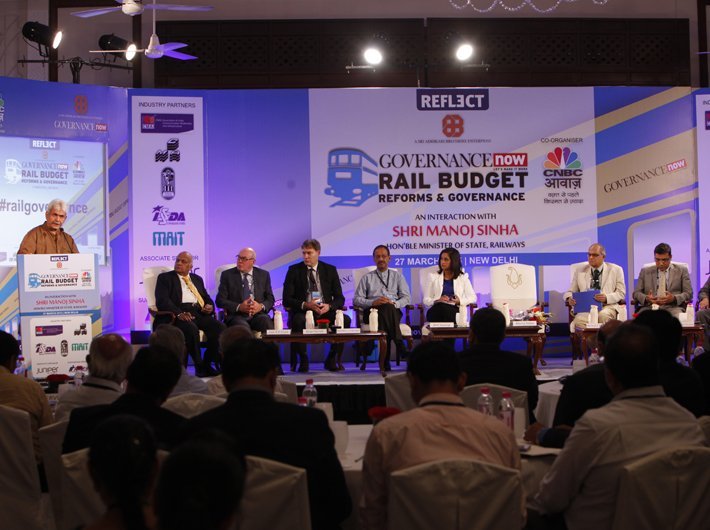Indian railways is looking at private investment not privatisation, said Manoj Sinha, minister of state for railways while delivering the keynote address at 'Rail Budget: Reforms & Governance’ conference in Delhi. The round table was part of the REFLECT knowledge exchange series organised by Governance Now in partnership with CNBC Awaaz.
READ: Railways to focus on safety: Manoj Sinha
Indian railways need Rs 8.5 lakh crore investment, said Sinha. “In about two months we will organise the second round of investors’ meet.” He further said that earlier there were issues of environmental clearances and land acquisition, we have now smoothened the process of interministerial coordination.
Speaking at the event, coal secretary Anil Swarup said that "we are moving towards 'cooperate federalism' whereby the central government will ensure delivery of funds." Talking about privatisation in the Indian railways, he said, “There is a huge difference between privatisation of railways and ensuring private investment in railways. Investment from the private sector should be encouraged.” About the railway budget Swarup said, “The rail budget is a new paradigm shift in the context of how funds should be managed.”
He talked about how CIL was planning to touch the target of 1 billion coal production by 2020. However, he said, “We face the major problem of carrying coal from the mines to the end user. We need to invest in technology to make this process smooth and efficient.”
Follow
#railgovernance
Sinha added that an MoU between centre, railways and Odisha government had been signed to facilitate transport of coal from mines to the end user. A similar arrangement has been made with Jharkahand.
On increase in coal production, Swarup said that in past six months CIL has reported an increase of 6-7% in coal production as compare to 2-3% earlier. “Due to proactiveness of the railways, various hurdles have been cleared in Chhattisgarh, Jharkhand and Odisha.”
About the kind of makeover needed in the Indian railways, Shailendra Chouksey, vice president, cement manufacturers’ association, said that the cement industry has real hopes from the Indian railways. The cement industry is the third largest consumer of railways. However, in last 10 years, the industry has witnessed a slump.
Talking about the viability of bringing investments in Indian railways, Benedict L J Eijbergen, program leader, infrastructure, World Bank India said that the World Bank was already engaged with the Indian government for various rail projects. He advised that investments must be targeted to improve efficiency and sustainability. For this, Eijbergen said, “The World Bank can help in setting up investment funds for railways, with proper assessment of viable projects that need to be undertaken.”
Eijbergen expressed concern of a huge lack of capital investment in Indian railways, by both public and private sector. He urged the government to come forward in this regard. He further added, “There is a lot of lip service, but concrete steps are hardly taken”.
Mrityunjay Kumar, country director, enterprise and channel business (India and SAARC), Juniper spoke about the technological aspects of railways. He said, “I see great hope in the railway budget. According to the data I have received, in 2013, the Indian railways carried eight billion people on a network of 65,000 km. That itself shows that the scale of implementation is real.”
He went on to highlight the aspect of mobility. As one of the fastest growing number of mobile and mobile internet users, Kumar said, “On a monthly basis, five million mobile users are being added. Mobility is bringing a whole lot of potential.”
Brian Parrott, minister (commercial), High Commission of Canada said that the cost per mile of moving coal is the lowest in Canada. “Our country also has state-of-the-art technology in signalling and manufacturing.”
“Right now we are negotiating an MoU with the rail ministry. Canada is keen on sharing technology and is looking for an opportunity to invest in rail sector. We are looking for ways in which Canada pension fund can benefit Indian railways. There is a huge opportunity in equipment and technology supplies. Our relationship with India is very important”, he said.
Nirmal C Mathur, president, Indian Stainless Steel Development Association, said that "we transport raw steel mostly via railways. However the finished steel products are transported mostly by road. Our association is a not-for-profit organisation. We believe steel coaches will be viable in the long run. We are also thinking for the long term. Keeping in tune with Swachh Bharat campaign, we have developed bio-toilets. We also look forward to participating in keeping station premises clean and providing hygienic food. We are eager to provide technical solutions”, he added.
NK Goyal, president, CMAI said, “The new government is moving in the right direction and things are improving. The industry needs to shed the old mindset and explore newer opportunities to work with government.”
“The government’s decision of investing Rs 8.5 lakh crore has given a positive signal to the industry globally. Now investors from Japan and Korea are willing to invest.”
He suggested that the government should appoint a committee on improving the procurement process in railways.
